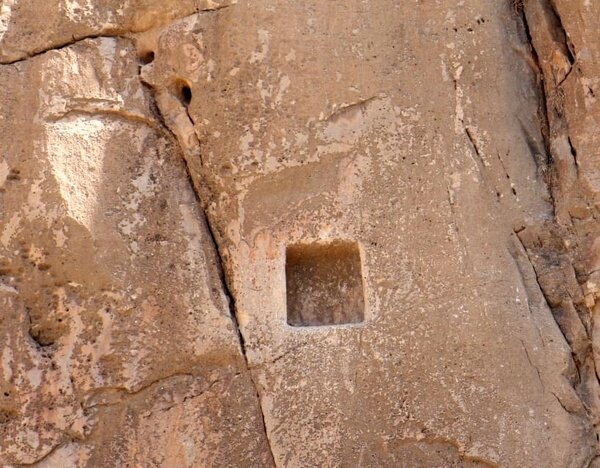Rock-carved tombstone discovered near Persepolis

TEHRAN – A researcher has found an ancient tombstone in Naqsh-e Rostam, which is one of the wonders of the ancient world situated near Persepolis, southern Iran.
The gravestone bears inscriptions in Pahlavi, which is a Middle Persian (sometimes called Middle Iranian) language, meaning that it was primarily used from the end of the Achaemenian dynasty (559–330 BC) to the advent of Islam in the 7th century CE.
“The rocky landscape of Naqsh-e Rostam has long been the site of various burials from the Sassanid era (onwards)… related to Zoroastrian monks who lived in this place,” ILNA quoted Iranian researcher Abolhassan Atabaki as saying on Sunday.
The reason for the diversity and extent of such burials was the large population of Istakhar (the ritual birthplace of the Sassanid kings), which is located at a close distance from the rocks of Nakhsh-e Rostam, he explained.
“For this reason, the people of Istakhar and the surrounding villages buried their dead bodies in the common manners of that time; they were buried in pits made in rocks or rocks.”
The burial of the dead in the gaps of rocks was because Zoroastrian believers in the Sassanid period believed that the soil is a dark and demonic world, and on the other hand, they believed that the body of a deceased person is impure, the researcher stated.
“They believed that the 'sacred element of the soil’ would be polluted by corpses. For this reason, they refused to bury the dead in soil.”
Atabaki said that the discovery of another burial inscription in his investigations in the heart of Nakhsh-e Rostam.
In the end, he added the text of all inscriptions that we have discovered in recent years would publish in conferences, magazines, and also a book titled Burials of Fars, authored by Najmeh Ebrahimi.
Naqsh-e Rostam is home to spectacular massive rock-hewn tombs and bas-relief carvings. The majestic site embraces four tombs where Persian Achaemenid kings are laid to rest, believed to be those of Darius II, Artaxerxes I, Darius I, and Xerxes I (from left to right facing the cliff), although some historians are still debating this.
Naqsh-e Rostam, meaning “Picture of Rostam” is named after a mythical Iranian hero which is most celebrated in Shahnameh and Persian mythology. Back in time, natives of the region had erroneously supposed that the carvings below the tombs represent depictions of the mythical hero.
There are stunning bas-relief carvings above the tomb chambers that are similar to those at Persepolis, with the kings standing on thrones supported by figures representing the subject nations below. There are also two similar graves situated on the premises of Persepolis probably belonging to Artaxerxes II and Artaxerxes III.
Beneath the funerary chambers are dotted with seven Sassanian eras (224–651) bas-reliefs cut into the cliff depict vivid scenes of imperial conquests and royal ceremonies; signboards below each relief give a detailed description in English.
AFM
Leave a Comment